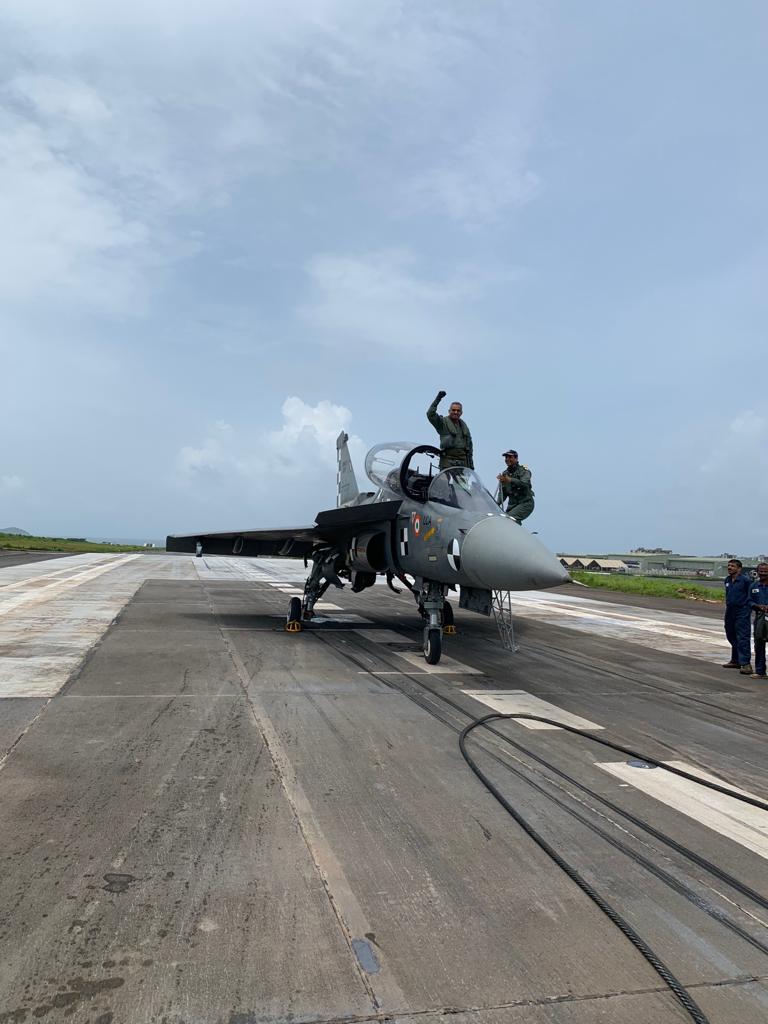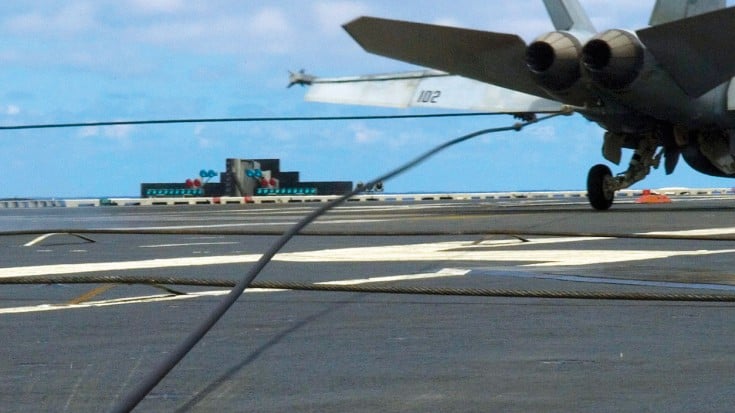
link


Now divide the arrester hook load of 37 tonnes by the weight (10.5 tonnes?) to get the deceleration.Kakarat wrote:First arrested landing of Naval LCA successful
...
The NP-1 was piloted by Cmde J A Maolankar (Chief Test Pilot) with
assistance from Capt Shivnath Dahiya (Landing Safety Officer) and Cdr
J D Raturi (Test Director)
...
Sources confirm that the landing speed of NP-1 was at 132 knots and
the sink rate at 4.4 m/s while the arrester hook load was about 37
tonnes.
...
Before carrier landings, we will see 5.6m+ sink rates achieved.Sources conrm that the landing speed of NP-1 was at 132 knots and the sink rate at 4.4 m/s while the arrester hook load was about 37 tonnes.
ramana wrote:...
LCA-N engineers and pilots need to be confident that the fighter can slam down onto the deck of a carrier at a 'sink rate' (rate of descent) of approximately 7.5 metres per second (1,500 feet per minute) without being damaged. Though they may not test the fighter to this limit immediately, they need to successfully prove that they can land with a sink rate of 5.6 metres per second to be qualified for carrier trials. At the moment, the jet has been tested with a sink rate of 5.1 metres per second.
https://twitter.com/writetake/status/11 ... 04677?s=19#JustIn
#NLCA NP-1 did another arrested landing today at SBTF Goa. The flight was piloted by Capt Shivnath Dahiya. That's back-to-back successful flights for Team ADA\ARDC. Good show!
https://t.co/6XRSK2gsBS
https://t.co/tcFfGU1DT4
It will teach us how to build Naval Aircrafts. It will help us learn control laws for carrier landings. It will help us to design the twin-engined fighter which may supersede the MRCA someday.VikramA wrote:What role will naval tejas serve if it is inducted? With navy wanting 57 twin engine MRCA in the form of mig 29k, f-18, naval raf, even if naval tejas is inducted in limited numbers of say 20 aircraft, how will it be used? As a fleet air defense fighter. Or will it replace the jag maritime strike aircraft( for that it does need AC landing ability)

1. Useful for training carrier pilots. Think of it as a LIFT.VikramA wrote:What role will naval tejas serve if it is inducted? With navy wanting 57 twin engine MRCA in the form of mig 29k, f-18, naval raf, even if naval tejas is inducted in limited numbers of say 20 aircraft, how will it be used? As a fleet air defense fighter. Or will it replace the jag maritime strike aircraft( for that it does need AC landing ability)
I think we love these milestones too boss.Rakesh wrote:First post in Page 1 of this thread has been updated.
Please check and kindly add any info if necessary.
Thanks.
Gorgeous shot. What is the source? I would love to add this in the first page.JayS wrote:Arrester hook engagement from the 2nd Recovery.
Did the hook engagement happened when the MLG were still yet to touch down..?? It looks like they are off the ground a few inches still. Or I have I gone blind..??
Maybe it is the airfcraft bouncing post-landing and post-arrest?JayS wrote:Arrester hook engagement from the 2nd Recovery.
Did the hook engagement happened when the MLG were still yet to touch down..?? It looks like they are off the ground a few inches still. Or I have I gone blind..??
Vips wrote:Noob Pooch. Is the arrester cable elevated or seamed on the deck/runway? Dont they get damaged or spiked when they run over the metallic cables at such high speed?


LCA FB pageRakesh wrote:Gorgeous shot. What is the source? I would love to add this in the first page.JayS wrote:Arrester hook engagement from the 2nd Recovery.
Did the hook engagement happened when the MLG were still yet to touch down..?? It looks like they are off the ground a few inches still. Or I have I gone blind..??
Quite thick steel wires designed to withstand huge loads, can surely handle aircraft trampling over it. That's not a problem for the wires. But the LG wheels do need to be of larger radius to be able to trample over easily. And the designers need to make sure the disturbance due to LG going over the wire does not interfere with the hook engagement. For ex, F35 initially faced issues as the hook was attached quite close to the MLG and the wires would not have enough time to get back in proper position to catch the hook, once the MLG pass over them. I don't know how exactly they solved it.Vips wrote:Noob Pooch. Is the arrester cable elevated or seamed on the deck/runway? Dont they get damaged or spiked when they run over the metallic cables at such high speed?
Yes, they are always elevated. The aircraft is checked for "bruising"Vips wrote:Noob Pooch. Is the arrester cable elevated or seamed on the deck/runway? Dont they get damaged or spiked when they run over the metallic cables at such high speed?
It is common practice to get the arrester hooked even before the wheels touchdown.JayS wrote:Arrester hook engagement from the 2nd Recovery.
Did the hook engagement happened when the MLG were still yet to touch down..?? It looks like they are off the ground a few inches still. Or I have I gone blind..??
There is a landing aid system to help pilot stay on proper glide path which then ensures he hits the deck at right spot. The one which STBF has is called LUNA Optical Landing System. Its russian of coarse. but same as American system I think, see youtube for videos how its done. Much easier to understand that way.RonyKJ wrote:Is there a way for the pilot to see the location of the cable and the arrestor hook while landing?
Or does he go by markings on the deck?
To be a long-term test pilot for R&D in IAF/IN means forfeiting promotions. Those who stay with the test flight program really love to fly!D.Mahesh wrote:Cmde.Mao is way too senior to be doing test flights. After several years on the Tejas, he's now working on NLCA. How about the next cohort taking over actual flight testing
Indranil wrote:He was never with Tejas. Always with LCA Navy. Some people have the passion to fly. Others are deskbound. A certain gent heading Boeing India now is the biggest impediment to LCA Navy Mk2. Any guesses which fighter he would want to see on Indian ships?!!!
https://www.business-standard.com/artic ... 018_1.htmlGroup Captain George Thomas, built like a bull, has commanded a squadron of Su-30MKIs. Group Captain Ritu Raj Tyagi, the most experienced of the group and a former Jaguar combat commander, ran the last Mumbai marathon as a diversion from flight testing. Captain Jaideep Maolankar, who cut his teeth flying Sea Harrier fighters off naval aircraft carriers, commanded warship INS Ganga as it chased pirates off the Somali coast. Group Captain Venugopal, like Varma, has commanded a MiG-21 squadron on the Pakistani border.
yensoy wrote:If the cable snaps, you also lose an expensive aircraft and an irreplaceable pilot; so I am sure there are procedures in place to ensure that cables don't snap.
your eyes are crystal clear. this would be the first arrestor cable, and pretty sure it would have landed by the time it hits the secondary (shown in the pic as well - the dark line that I think it is.)JayS wrote:Arrester hook engagement from the 2nd Recovery.
Did the hook engagement happened when the MLG were still yet to touch down..?? It looks like they are off the ground a few inches still. Or I have I gone blind..??
At around 0.04 sec of the video, it hits the primary. At around 0.5, you see nTejas cross the secondary. watch it in 0.25 playback speed.Kakarat wrote: